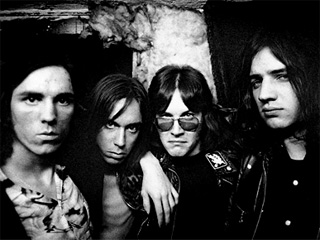The Vine interview: James Williamson of The Stooges, December 2010
An interview with The Stooges‘ guitarist James Williamson for The Vine. Excerpt below.
Fact: The Stooges are one of the most influential rock bands of all time.
Fact: Raw Power is one of the most influential rock albums of all time.
Released in 1973 to sparse acclaim and an underwhelming commercial performance – Raw Power peaked at #182 on the Billboard charts – the album eventually spread like a virus throughout the next generation of rock musicians, many of whom would introduce their own fans to The Stooges. Among them: Kurt Cobain, who named Raw Power his all-time favourite; Johnny Marr of The Smiths (and, more recently, Modest Mouse and The Cribs); Henry Rollins (who has the words ‘Search And Destroy’ tattooed across his shoulder blades); and Steve Jones of The Sex Pistols, who says he learned to play guitar by taking speed and playing along to Raw Power.
Of the album’s guitarist, James Williamson (main pic, far left – 1972), Johnny Marr said: “I’m his biggest fan. He has the technical ability of Jimmy Page without being as studious, and the swagger of Keith Richards without being sloppy. He’s both demonic and intellectual, almost how you would imagine Darth Vader to sound if he was in a band.” Williamson first joined The Stooges in 1971 as second guitarist, but the band was dissolving before his eyes. Only a recording offer from David Bowie to Williamson and vocalist Iggy Pop got them back together for one last stab at rock stardom as The Stooges. With the Asheton brothers in tow – Scott (drums) and Ron (bass at the time, but he’d later play guitar during more recent incarnations of the band, up until his death in 2009) – Williamson co-wrote Raw Power with Iggy and played all of the guitar parts. Despite Bowie’s involvement, though, the record didn’t perform commercially, and the band again split. Williamson went on to collaborate with Iggy as a writer and producer for a couple of Pop’s solo ventures (1977’s Kill City and 1979’s New Values), but after falling out with the singer over Soldier’s recording methods, the pair remained estranged for 16 years.
What happened next is one of rock music’s strangest tales: James Williamson gave up on music entirely, graduated from California State Polytechnic University with a degree in electrical engineering, and went on to work for Sony Electronics for 25 years. Most of his colleagues had no idea of Williamson’s involvement with The Stooges, despite Iggy Pop doggedly working himself into a position of international notoriety as one of rock’s most outlandish performers. The Raw Power guitarist wanted nothing to do with it. It took a university essay written by Williamson’s son, entitled ‘Coffins In The Corner’ – in reference to his father’s guitar cases sitting up against the wall, unopened all throughout his childhood and adolescence – to provoke the guitarist to finally accept Iggy’s offer to reform the band in the wake of Ron Asheton’s death last year. It also helped that Sony offered him a generous early retirement package from his role as Vice President of Technology Standards. Now Williamson, aged 61, is touring the world, playing The Stooges’ celebrated catalogue to a new generation. The Vine connected with the guitarist ahead of the band’s appearance on the Big Day Out tour in January and February 2011.
—
Andrew, how are you doing?
I’m very well, thanks. It’s 7 a.m.
7a.m.? [laughs] I’m sorry to put you through that, but I guess we could find the time we could both do it.
Absolutely. It’s an honour, mate. I found your website while I was researching for this interview. I was intrigued by a couple of things. First, what’s the origin of your nickname?
Oh, Straight James? After The Stooges had split up, Iggy came out with an album called The Idiot, and he had a song on there called ‘The Dum Dum Boys’ (link). In that song he talks about “Ron did this,” and “Scott, he did that”, and then “What about James? He’s gone straight”. So after that, I tongue-in-cheek named my publishing company ‘Straight James Music’ and it kinda stuck from there. I’ve had it ever since.
For the full interview, visit The Vine.
For more of The Stooges, visit your local record store / online outlet and immediately buy/download their three albums: The Stooges, Fun House, and Raw Power. Thank me later.

